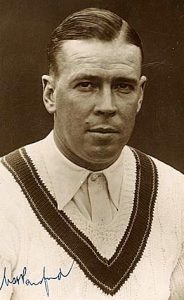Colourblindness and cricket
I have been musing on my own personal cricketing failings and I have always suspected that I am handicapped by being colour blind. Think about it. How do you fancy spotting a red ball on a green background with an inability to tell red and green apart? It turns out the medical literature has already considered the issue of colour blind cricketers and is there to back up my plaintive pleas.
There is an expected prevalence of around 8% in the male population for colour-vision deficiency. Of course, an incidence of 8-9% means there is likely to be one colour blind player in every team. Previous studies quoted have suggested rates as low as 4% in first class county cricketers. One study° looked at 293 cricketers from seven cricket clubs in Melbourne. They found that 8.9% had colour-vision deficiencies but only 6.7% played at the highest level within those clubs. However, that reduction in those playing at the highest level is statistically significant.
This could lead one to the conclusion that being colour blind is holding some cricketing men back. This study also looked at some other interesting areas which might prove useful for the village cricket bluffer and will provide ample ammunition to mount a robust defence of any mishaps.
The batting average in those with mild colour-vision deficiencies was 28.3 and those with severe deficiencies was 18.8. (Sadly, the authors report this was not statistically significant but don’t let that stand in the way of your bar-room thesis during the match post-mortem.) It was also noted that those with colour-vision deficiencies rather prefer fielding close to the batter. This might prove a highly useful piece of hard medical evidence for those that find galloping around a boundary rope somewhat wearing. The authors have included some technical explanations which will help beat back any naysayers.
A further hypothesis is that cricketers with abnormal colour vision will have greatest difficulty when fielding in the outfield where the angular size of the ball is small and the ball may often be seen against grass or surrounding foliage. The ball subtends about 12 minutes of arc for a fielder close to the batsman and three to five minutes of arc for a fielder near the boundary. It is known that all observers with abnormal colour vision, even those with a mild deficiency, have difficulty seeing red objects in natural surrounds. For these reasons cricketers with abnormal colour vision should prefer to field close to the batsman. Botham was a brilliant slip fielder…
W.H. Ponsford (pictured) was known to be colour blind but he has the 6th highest average in first class cricket° in the history of the game. He doesn’t always make the lists because he never met the 20,000 run minimum that is often applied. He also scored over 400 twice in first class innings. Only Brian Lara can match that.
Rather amazingly 42% of men in this study did not know they had any colour-vision deficiency. So the next time you shell a dolly at long-off perhaps you ought to toddle down to your GP and do an Ishihara test.° Being colour blind could provide some convenient excuses.
Reference
Harris, R., & Cole, B. (2007). Abnormal colour vision is a handicap to playing cricket but not an insurmountable one Clinical and Experimental Optometry, 90 (6), 451-456
